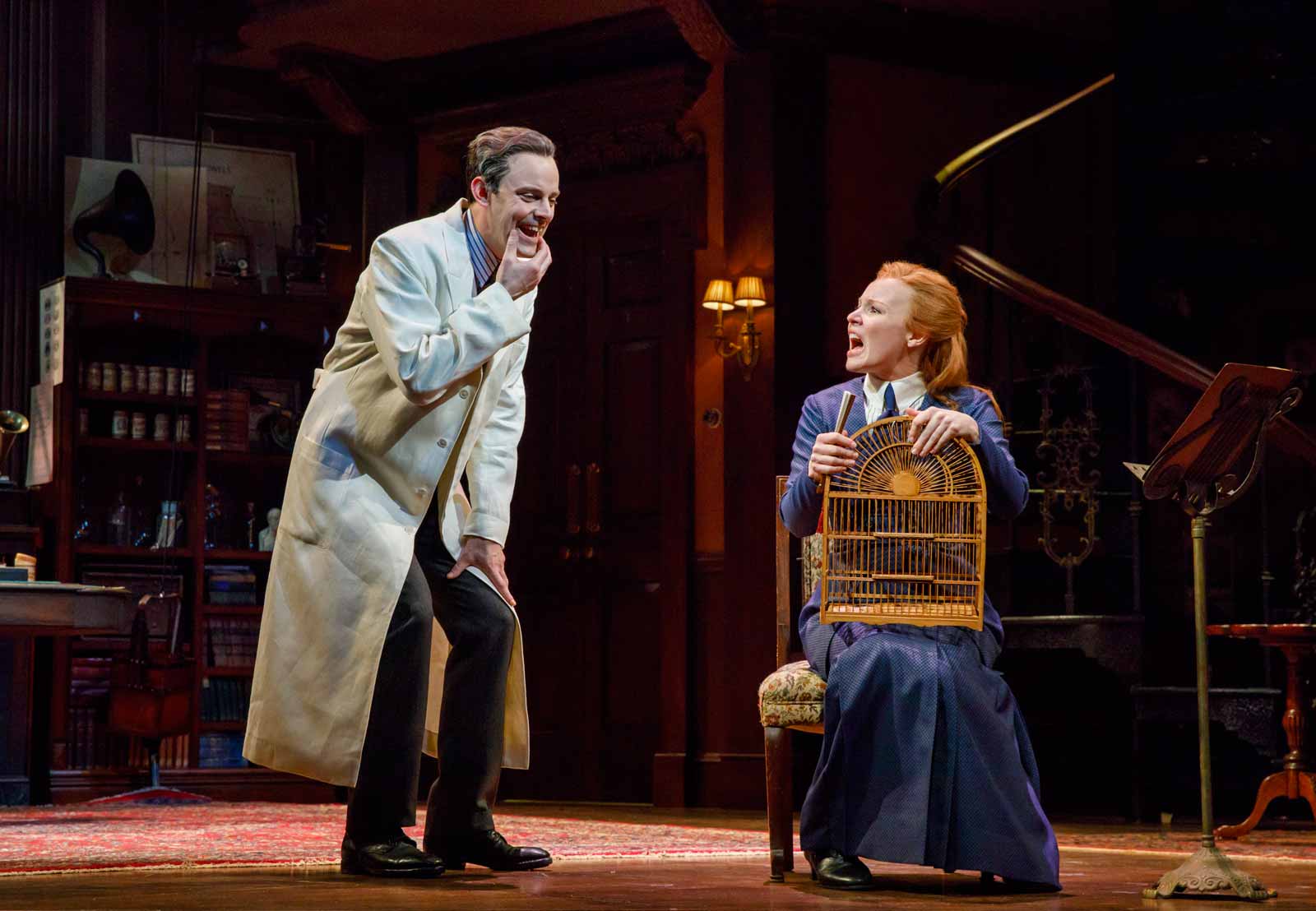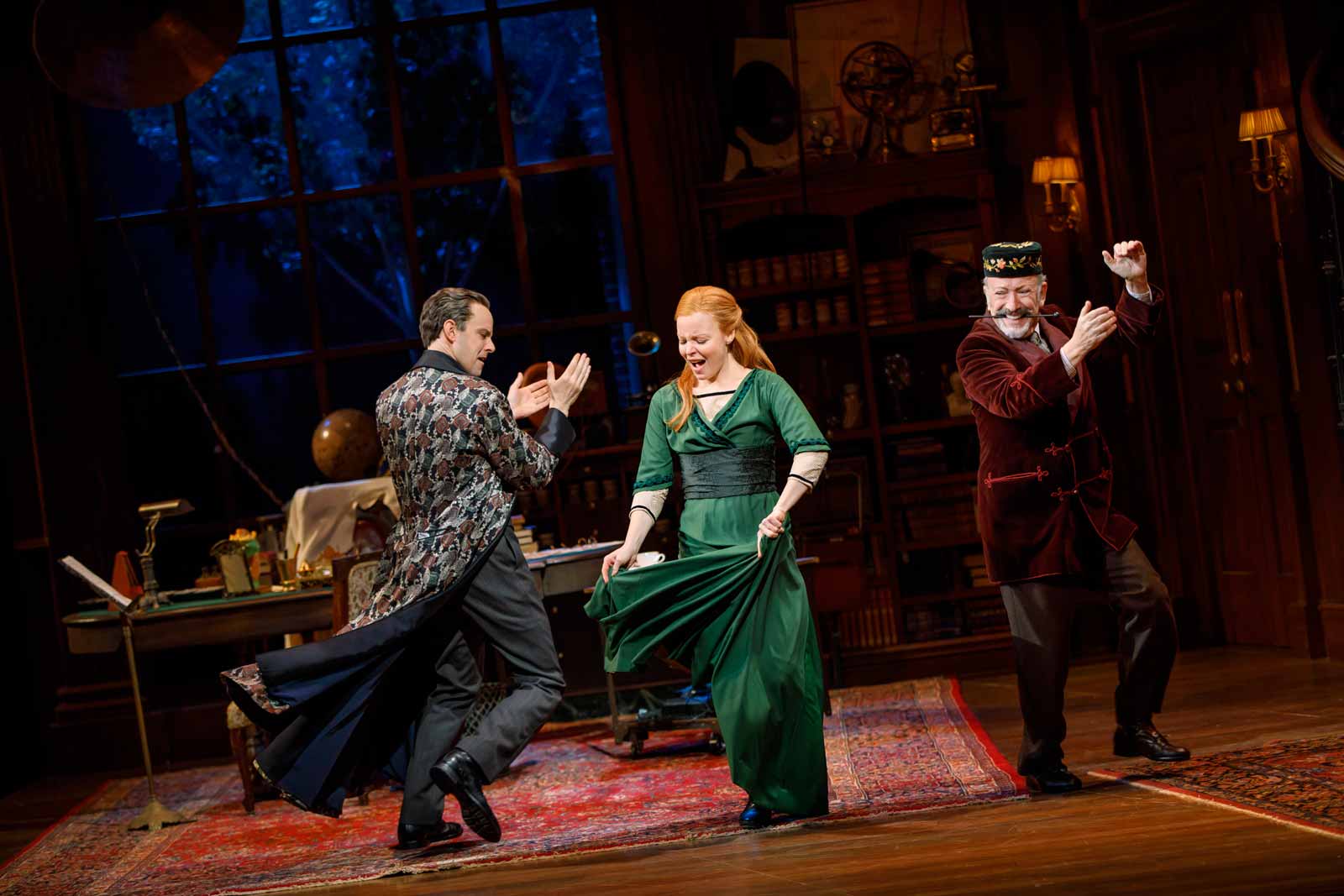Everything works perfectly in Bartlett Sher’s brilliant new production of My Fair Lady. The sets (by Michael Yeargan) are wonderful; the costumes (Catherine Zuber) are splendid; and the cast, led by Lauren Ambrose as Eliza and Harry Hadden-Paton as Higgins, is first rate. But above all, the musical, so often seen before, feels entirely fresh.
Sher’s My Fair Lady is actually more faithful to George Bernard Shaw’s original concept of his play, Pygmalion, upon which the musical is based, than any production before, including the famous movie with Audrey Hepburn and Rex Harrison. At the very end of the show, Eliza Doolittle, the cockney flower-seller instructed in how to be an upper-class lady by Henry Higgins, the gentleman scholar, proudly walks away from her self-centered control freak of a teacher. Even as Higgins persists in asking her for his slippers, she “sweeps out,” as Shaw had directed, to claim her independence.
Ambrose’s spirited Eliza might seem like an anachronism, tailored to an audience suffused with #MeToo sentiments. And Hadden-Paton’s Higgins might be seen as a typical “mansplainer” who just doesn’t get how times have changed. But Ambrose comes much closer to Shaw’s Eliza than Hepburn, or any of her predecessors in the role.
Shaw’s ideal of female emancipation was, in fact, sabotaged from the very beginning. In the first London production in 1914, to the disgust of the author, Herbert Beerbohm Tree playing Higgins gives Eliza (Mrs. Stella Patrick Campbell) a loving look, intimating a happy life together. When the movie of Pygmalion, starring Leslie Howard and Wendy Hiller, was made in 1938, the Hollywood producers insisted on a romantic ending, too. And a similar dose of sugar was sprinkled on the conclusion of the Harrison-Hepburn film.
Like the musical, Shaw’s play, too, was based on an older story, the Greek myth about Galatea, the milk-white beauty sculpted by Pygmalion of Cyprus. After carving his perfect woman out of ivory, he falls in love with her. Answering his prayers, Aphrodite gives her life, and the artist and his feminine ideal live as man and wife. This is a story that could signify many things, but one of the themes is artistic obsession, about a man who only has eyes for his own creation.
Shaw’s main interest, on the other hand, was in class and the role of language in defining social rank in Britain. The art of Henry Higgins, as obsessed as the Greek Pygmalion, is to place people by their accents with absolute precision. He can tell by any given English accent not only in which town someone is born, but exactly where in that town. And naturally, he can detect every shade of social class. When he hears Eliza for the first time, selling flowers in Covent Garden, he can even tell which street she grew up in. His loyal companion, Colonel Pickering, played in the current production by Allan Corduner, is immediately pinned down to his school, university, and last place of residence: Harrow, Cambridge, and India.
This is something of a joke, of course, but only up to a point. Until quite recently, and perhaps to some extent still, British people were cursed or privileged by their class. The right or wrong accent, like the right shoes or the wrong tie, could determine a person’s life. Language shaped one’s identity.
That Oscar Wilde and George Bernard Shaw, two of the greatest theatrical satirists of British class, were both Irish is surely no coincidence. They had the acid eyes of born outsiders. Wilde was a libertarian dandy, who ridiculed British conventions. Shaw was a fierce critic of class snobbery, and a defender of women’s rights at a time when women didn’t even have the right to vote.
Higgins, too, in all his incarnations, including Hadden-Paton’s, is a nonconformist of a kind, and rather like Pygmalion, an artist in love with his own creations. His sculpture, as it were, of the ideal woman is thus Eliza. But he also talks a great deal about the human soul, even as he refuses to recognize one in Eliza.
One of the most moving scenes, in the movies, as well as in the current production, is the private celebration after the ball, where Eliza manages to pass for the first time as a grand lady. Higgins is toasted by all his servants: “Congratulations, Professor Higgins, for your glorious victory.” And Pickering sings:
You did it! You did it! You did it!
They thought she was ecstatic
And so damned Aristocratic,
And they never knew that you did it!
All the while, Eliza sits in a corner, utterly ignored, as though she had played no active part in her transformation from a flower girl to a lady, as though she were nothing but Higgins’s artifact. This is also the moment of her rebellion. She throws a fit and pelts Higgins with his precious slippers.
Advertisement
The question is what happens to the human soul when social identity changes. Eliza speaks a new language and has a new set of manners, to match her new jewels and clothes. That Cecil Beaton, who designed the clothes and the sets for the movie of My Fair Lady, will forever be associated with the musical is entirely justified, for the look tells the story. The ladies are so tightly cocooned in their extravagant and fanciful gowns that they appear to be imprisoned in them; evening dress as a kind of bondage.
But who is Eliza now? Where is her soul? Like Pygmalion, though with much less ardor, Higgins falls in love with her, as he thinks: “I’ve grown accustomed to her face.” But it is not her soul that he loves, but only the well-spoken, beautifully dressed, fine-mannered figure that he shaped.
To end the play, or film, or musical, with the artist and his creation falling into romantic bliss is indeed a betrayal of Shaw’s intentions. For to be free, in the way Shaw wanted women to be free, Eliza has to break with Higgins. And Higgins is too much of an artist to be content with being tied down in a conventional marriage anyway. His famous song, “I’m an Ordinary Man,” in which he advises, “Let a woman in your life, and you invite eternal strife,” may sound like the expression of a typical male chauvinist. And in a way, that is just what it is. But it is also the sentiment of a man who can only live for his work.
And so, they must part ways. Shaw actually wrote an alternative ending for the movie with Leslie Howard. In that version, which the producers rejected, Eliza marries the penniless upper-class twit Freddy Eynsford-Hill, and runs her own flower shop. This, too, seems unsatisfactory. It is much better to turn around and walk away, as Lauren Ambrose does with such panache.
My Fair Lady, directed by Bartlett Sher (book by Alan Jay Lerner; music by Frederick Loewe), is at the Vivian Beaumont Theater, New York, through January 2019.




